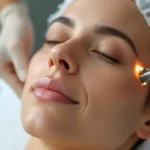Hair loss is a condition that involves the thinning or complete loss of hair from parts of the head or body. It results from a variety of factors, including heredity, hormonal changes, medical conditions, or a normal part of aging. There are many treatments available for managing hair loss. Here’s information on the different types of treatments and their benefits:
Head Hair Loss Treatments
Scalp hair loss is the most common form of hair loss, and several treatments are available to address it. These options range from non-invasive medications to advanced surgical and therapeutic procedures. Here are some commonly used treatment methods:
Hair Medications
Topical solutions and oral medications are often the first line of treatment for hair loss. These products work in various ways, like stimulating hair follicles or blocking hormones that contribute to hair thinning. The main benefit of medication is its non-invasive nature. It can be a convenient option for slowing the progression of loss and, in some cases, promoting new hair growth with consistent use.
Hair Transplants and Extractions
Follicular unit transplantation (FUT) and follicular unit extraction (FUE) are two primary methods of surgical hair restoration. In FUT, a strip of scalp containing hair follicles is removed from a donor area and dissected into individual grafts for transplantation. FUE involves extracting individual follicular units directly from the scalp.
The key benefit of both procedures is their ability to provide significant, natural-looking results for areas of advanced loss. They offer a permanent solution by transplanting hair that is resistant to thinning. FUE, in particular, benefits patients by leaving minimal linear scarring, which allows for shorter hairstyles.
PRP and ACell Therapies
Platelet-rich plasma (PRP) therapy and ACell therapy are regenerative treatments, used alone or with hair transplant surgery. PRP therapy involves using a concentration of a patient’s own platelets to help stimulate hair growth. ACell is a product that can be used to create a supportive structure for tissue regeneration. When used together, their benefits may include strengthening existing hair, promoting the growth of thinning hair, and potentially accelerating healing after a hair transplant procedure. These therapies provide a non-surgical approach to improving hair density and health.
Facial Hair Treatments
For individuals experiencing loss of hair on the face, specific procedures help restore hair to the beard and eyebrow areas. These treatments are designed to create a natural-looking and fuller appearance. A beard transplant is a procedure that moves hair follicles from a donor area, typically the back of the scalp, to the beard region. The primary benefit is the ability to create a fuller, more defined beard. This can address patchiness or complete hair loss in the facial area.
An eyebrow transplant similarly moves individual hair follicles to the brow line. This procedure can reconstruct thinning or nonexistent eyebrows. The benefit is the creation of natural, permanent eyebrows that frame the face and can enhance facial symmetry.
Body Hair Treatments
Hair transplantation techniques are not limited to the head and face. They can also be applied to restore hair on other parts of the body, like the chest or pubic area, for individuals who desire more density. The process is similar to scalp hair transplants, using donor hair from the head. The benefit is the ability to achieve a desired aesthetic appearance in areas affected by hair loss due to genetics, scarring, or other causes.
Schedule an Appointment Today
Discussing your specific situation and goals with a qualified professional can help you determine what treatment is most suitable for your hair goals. An expert can evaluate your pattern of hair loss, discuss your expectations, and develop a customized treatment plan. Contact a provider today to learn more about hair restoration.















